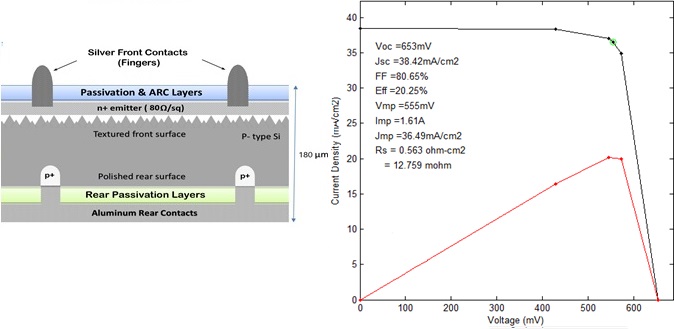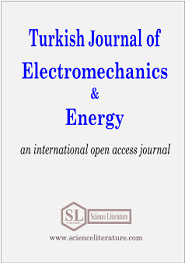
Layout optimization for shingled solar cells
Abstract
Increasing a photovoltaic (PV) module’s output power density is a reliable way to reduce electricity production costs. Along with improving solar cell conversion efficiency, another strategy is to minimize electrical and optical cell-to-module losses. The shingled photovoltaic module is a high-power PV module created by dividing and bonding cells with an electrically conductive adhesive (ECA). When compared to standard modules, the shingling approach has several advantages: lower ohmic losses, better area utilization, resulting in increased energy yield and better aesthetic appearance. As a result, it is critical to design the solar cell layout to achieve the best efficiency by limiting shading loss in the solar cell and must be planned accordingly. In this study, simulations are made using different finger and busbar numbers to determine the layout used to produce shingled cells. As a result of the simulations, managed the optimum efficiency and fill factor value with the number of 5 busbars and 110 fingers.
Full Text:
PDFReferences
J.D.C. Dickson “Photo-voltaic semiconductor apparatus or the like,” US2938938A, USA 2, 933-938, May 31, 1960.
D. M. Chapin, C. S. Fuller, and G. L. Pearson, “A new silicon p-n junction photocell for converting solar radiation into electrical power,” Semiconductor Devices: Pioneering Papers, pp. 969-970, 1991.
M. Mittage, T. Zech, M. Wiese, D. Bläsi, M. Ebert, H. Wirth, “Cell-to-Module (CTM) analysis for photovoltaic modules with shingled solar cells,” In 44th IEEE Photovoltaic Specialist Conference (PVSC), 25-30 June 2017, Washington, USA. Available: IEEE Xplore, https://ieeexplore.ieee.org. [Accessed: 04 November 2018].
L. C. Rendler, P. Romer, A. J. Beinert, J. Walter, S. Stecklum, A. Kraft, U. Eitner, S. Wiese, “Thermomechanical stress in solar cells: Contact pad modeling and reliability analysis,” Solar Energy Materials and Solar Cells, vol. 196, p.167-177, July 2019.
S. Braun G. Hahn, R. Nissler, C.Pönisch, D. Habermann, “Multi-busbar solar cells and modules: High efficiencies and low silver consumption,’’ In Silicon PV, March 25-27, 2013, Hamelin, Germany. Available: Energy Procedia, https://www.sciencedirect.com/journal/energy-procedia. [Accessed: 27 March 2013].
L. Papargyri, M. Theristis, B. Kubicek, T. Krametz, C. Mayr, P. Papanastasiou, G. E. Georghiou, “Modelling and experimental investigations of microcracks in crystalline silicon photovoltaics,” Renewable Energy, vol.145, pp. 2387-2408, January 2020.
M. E. Şahin, H. İ. Okumuş, “Physical Structure, Electrical Design, Mathematical Modeling and Simulation of Solar Cells and Modules,” Turkish Journal of Electromechanics & Energy, 1(1), pp. 5-12, 2016.
L. Theunissen, B. Willems, J. Burke, D. Tonini, M. Galiazzo, and A., Henckens, “Electrically conductive adhesives as cell interconnection material in shingled module technology,” AIP Conference Proceedings 2018. Available: https://aip.scitation.org/. [Accessed: 10 August 2018].
M. Mittang, T. Zech, M. Wiese, D. Blasi, M. Ebert, H. Wirth, “Cell-to-Module (CTM) Analysis for Photovoltaic Modules with Shingled Solar Cells,” in 44th IEEE Photovoltaic Specialist Conference (PVSC), Washington, USA, 25-30 June 2017. Available: IEEE Xplore, https://ieeexplore.ieee.org [Accessed: 04 November 2018].
G. Beaucarne, I. Kuzma-Filipek, F. Campeol, X. Young, J. Wei, Y. Yu, R. Russell, F. Duerinckx, “Innovative cell interconnection based on ribbon bonding of busbarless cells using silicone-based electrically conductive adhesives,” Energy Procedia, vol. 67, p. 185-193, April 2015.
S. Guo, J. Schneider, F. Lu, H. Hanifi, M. Turek, M. Dyrba, I.M. Peters, “Investigation of the short-circuit current increase for PV modules using halved silicon wafer solar cells,” Solar Energy Materials & Solar Cells, vol. 133, p. 240-247, February 2015.
V. Shanmugam, T. Mueller, A. G. Aberle, J. Wong, “Determination of metal contact recombination parameters for silicon wafer solar cells by photoluminescence imaging,” Solar Energy, 2015, vol. 118, p. 20-27, August 2015.
] H.-W. Cui, D.-S. Li, Q. Fan, H.-X. Lai, “Electrical and mechanical properties of electrically conductive adhesives from epoxy, micro-silver flakes, and nano-hexagonal boron nitride particles after humid and thermal aging,” International Journal of Adhesion & Adhesives, vol. 44 p. 232-236, July 2013.
W. Qiao, H. Bao, X. Li, S. Jin, Z. Gu, “Research on electrical conductive adhesives filled with mixed filler,” International Journal of Adhesion and Adhesives, vol. 48, p. 159-163, January 2014.
S. Y. Eom, S. B. Seo, K. Y. Lee, “Study on cure behavior of low temperature and fast cure epoxy with mercaptan hardener”, Polymer (Koera), vol. 37, p. 240-248, March 2013.
T-H. Jung and H-E. Song, “A mathematical model for cell-to-module conversion considering mismatching solar cells and the resistance of the interconnection ribbon,” Solar Energy, vol. 103, p. 253-262, May 2014.
J. Rabanal-Arabach, D. Rudolph, I. Ullmann, A.
Halm, A. Schneider, T. Fischer, “Cell-to-Module Conversion Loss Simulation for Shingled-Cell Concept,” In Proceedings of the 33rd European PV Solar Energy Conference and Exhibition, 25-29 September 2017, Netherlands, Holland. Available: https://www.researchgate.net.
S. Tahir, A. Ali, N. Amin, M. I. Arshad, “The Effect of Nonuniform Emitter Sheet Resistance on PERC Solar Cell Performance,” Silicon, vol. 11, p. 393–399, May 2019.
J. Wong. “Griddler: Intelligent computer aided design of complex solar cell metallization patterns,” In Proceedings of the 39th IEEE Photovoltaic Specialists Conference, 16-21 June 2013, Tampa, Florida. Available: IEEE Xplore, https://ieeexplore.ieee.org/
T. Panda, S. Sadhukhan, S. Acharyya, P Banerjee, A. Nandi, S. Bose, N. Mondal, G. Das, S. Maity, P. Chaudhuri, H. Saha, “Impact of multi-busbar front grid patterns on the performance of industrial type c-Si solar cell,” Solar Energy, vol. 236, p. 790-801, April 2022.
M-J. Park, J. Song, D. Moon, and C. Jeong, “Improvement in the Power of Shingled-Type Photovoltaic Module by Control of the Overlapped Width,” Journal of the Korean Physical Society, vol. 77, p. 1040-1043, November 2020.
URN: https://sloi.org/urn:sl:tjoee73260
Copyright (c) 2022 Turkish Journal of Electromechanics and Energy

This work is licensed under a Creative Commons Attribution-NonCommercial 4.0 International License.

 Indexed in:
Indexed in:















